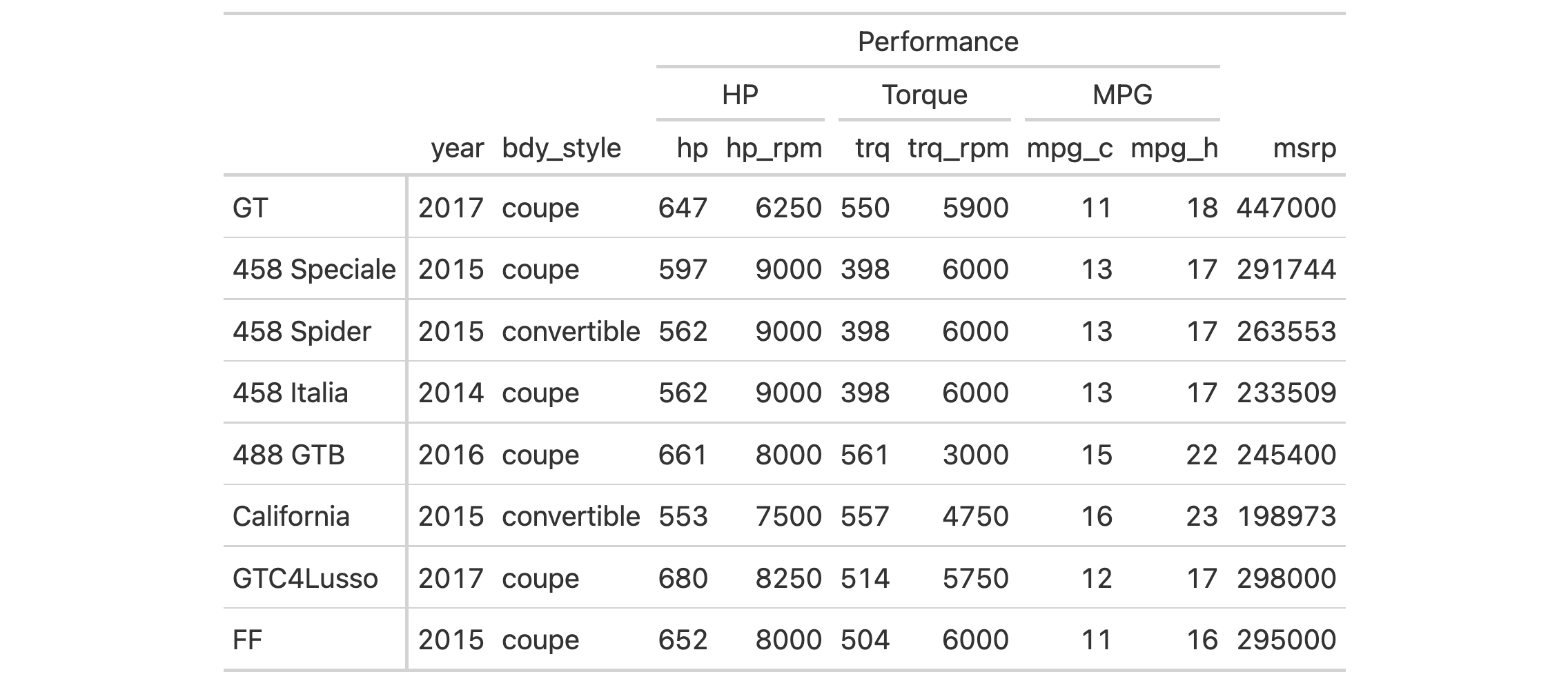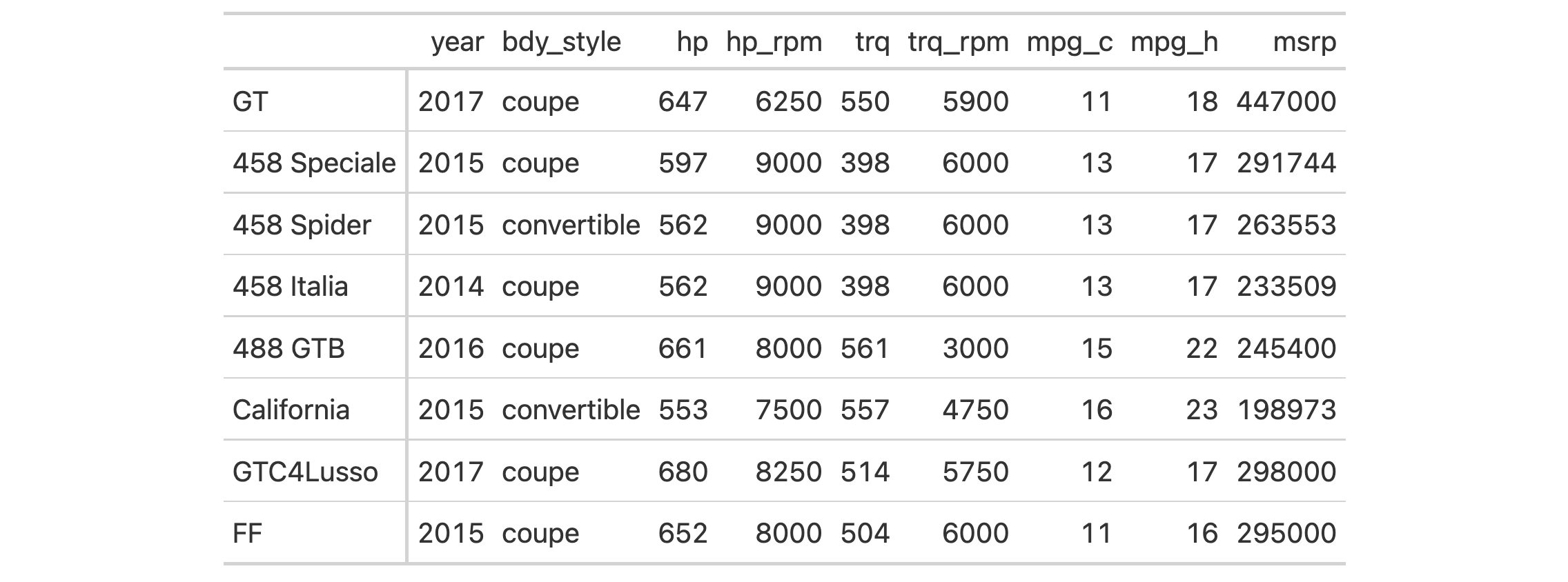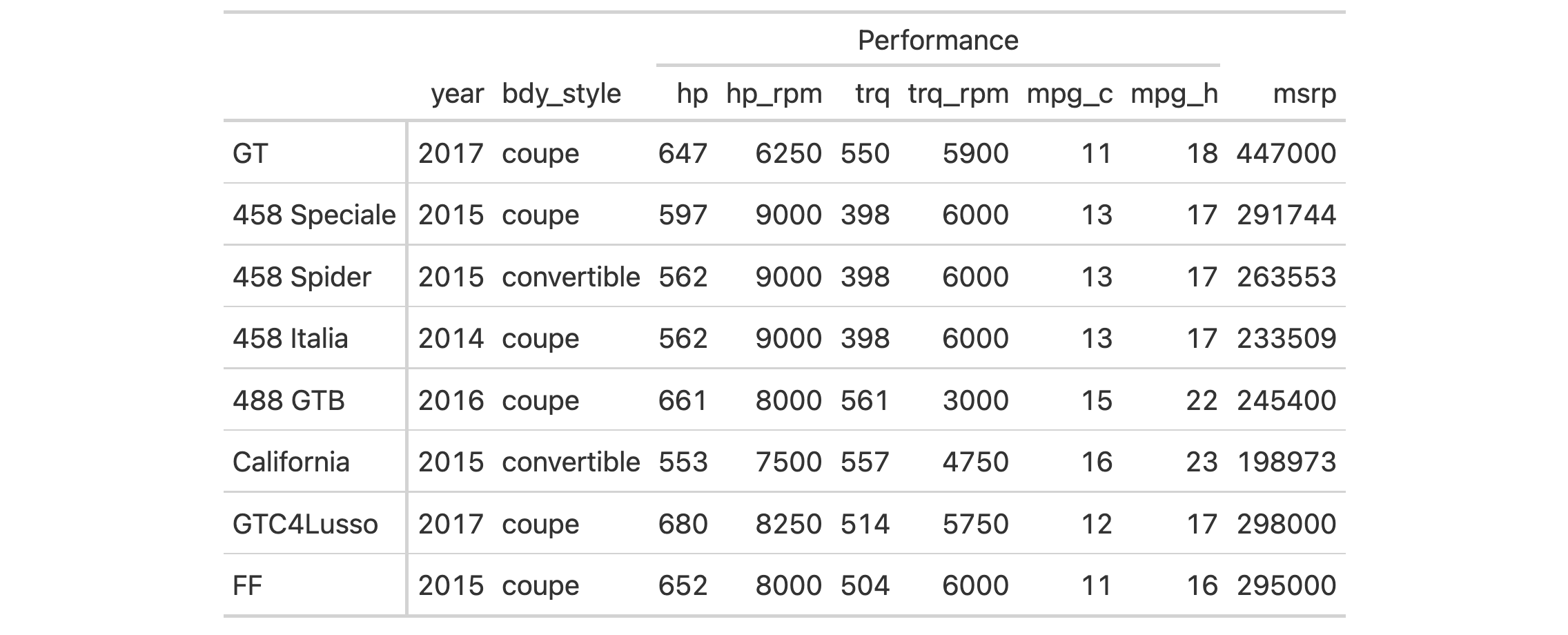rm_spanners: Remove column spanner labels
In gt: Easily Create Presentation-Ready Display Tables
rm_spanners R Documentation
Remove column spanner labels
Description
If you would like to remove column spanner labels then the rm_spanners()
function can make this possible. Column spanner labels appear above the
column labels and can occupy several levels via stacking either through
tab_spanner() or tab_spanner_delim(). Spanner column labels are
distinguishable and accessible by their ID values.
This function for removal is useful if you have received a gt table
(perhaps through an API that returns gt objects) but would prefer that
some or all of the column spanner labels be removed. This function is safe to
use even if there are no column spanner labels in the input gt_tbl object
so long as select helpers (such as the default everything()) are used
instead of explicit ID values.
Usage
rm_spanners(data, spanners = everything(), levels = NULL)
Arguments
data
The gt table data object
obj:<gt_tbl> // required
This is the gt table object that is commonly created through use of the
gt() function.
spanners
Spanners to remove
<spanner-targeting expression> // default: everything()
A specification of which spanner column labels should be removed. Those to
be removed can be given as a vector of spanner ID values (every spanner
column label has one, either set by the user or by gt when using
tab_spanner_delim()). A select helper can also be used and, by default,
this is everything() (whereby all spanner column labels will be removed).
levels
Spanner levels to remove
scalar<numeric|integer> // default: NULL (optional)
Instead of removing spanner column labels by ID values, entire levels of
spanners can instead be removed. Supply a numeric vector of level values
(the first level is 1) and, if they are present, they will be removed.
Any input given to level will mean that spanners is ignored.
Value
An object of class gt_tbl.
Examples
Use a portion of the gtcars dataset to create a gt table. With
tab_spanner(), we can group several related columns together under a
spanner column. In this example, that is done with several tab_spanner()
calls in order to create two levels of spanner column labels.
gt_tbl <-
gtcars |>
dplyr::select(
-mfr, -trim, bdy_style, drivetrain,
-drivetrain, -trsmn, -ctry_origin
) |>
dplyr::slice(1:8) |>
gt(rowname_col = "model") |>
tab_spanner(label = "HP", columns = c(hp, hp_rpm)) |>
tab_spanner(label = "Torque", columns = c(trq, trq_rpm)) |>
tab_spanner(label = "MPG", columns = c(mpg_c, mpg_h)) |>
tab_spanner(
label = "Performance",
columns = c(
hp, hp_rpm, trq, trq_rpm,
mpg_c, mpg_h
)
)
gt_tbl

If you decide that you don't want any of the spanners in the gt_tbl object,
they can all be removed with rm_spanners().
rm_spanners(data = gt_tbl)

Individual spanner column labels can be removed by ID value. In all the above
uses of tab_spanner(), the label value is the ID value (you can
alternately set a different ID value though the id argument). Let's remove
the "HP" and "MPG" spanner column labels with rm_spanners().
rm_spanners(data = gt_tbl, spanners = c("HP", "MPG"))

We can also remove spanner column labels by level with rm_spanners().
Provide a vector of one or more values greater than or equal to 1 (the
first level starts there). In the next example, we'll remove the first level
of spanner column labels. Any levels not being removed will collapse down
accordingly.
rm_spanners(data = gt_tbl, levels = 1)

Function ID
7-3
Function Introduced
v0.8.0 (November 16, 2022)
See Also
Other part removal functions:
rm_caption(),
rm_footnotes(),
rm_header(),
rm_source_notes(),
rm_stubhead()
gt documentation built on April 12, 2025, 1:26 a.m.
| rm_spanners | R Documentation |
Remove column spanner labels
Description
If you would like to remove column spanner labels then the rm_spanners()
function can make this possible. Column spanner labels appear above the
column labels and can occupy several levels via stacking either through
tab_spanner() or tab_spanner_delim(). Spanner column labels are
distinguishable and accessible by their ID values.
This function for removal is useful if you have received a gt table
(perhaps through an API that returns gt objects) but would prefer that
some or all of the column spanner labels be removed. This function is safe to
use even if there are no column spanner labels in the input gt_tbl object
so long as select helpers (such as the default everything()) are used
instead of explicit ID values.
Usage
rm_spanners(data, spanners = everything(), levels = NULL)
Arguments
data |
The gt table data object
This is the gt table object that is commonly created through use of the
|
spanners |
Spanners to remove
A specification of which spanner column labels should be removed. Those to
be removed can be given as a vector of spanner ID values (every spanner
column label has one, either set by the user or by gt when using
|
levels |
Spanner levels to remove
Instead of removing spanner column labels by ID values, entire levels of
spanners can instead be removed. Supply a numeric vector of level values
(the first level is |
Value
An object of class gt_tbl.
Examples
Use a portion of the gtcars dataset to create a gt table. With
tab_spanner(), we can group several related columns together under a
spanner column. In this example, that is done with several tab_spanner()
calls in order to create two levels of spanner column labels.
gt_tbl <-
gtcars |>
dplyr::select(
-mfr, -trim, bdy_style, drivetrain,
-drivetrain, -trsmn, -ctry_origin
) |>
dplyr::slice(1:8) |>
gt(rowname_col = "model") |>
tab_spanner(label = "HP", columns = c(hp, hp_rpm)) |>
tab_spanner(label = "Torque", columns = c(trq, trq_rpm)) |>
tab_spanner(label = "MPG", columns = c(mpg_c, mpg_h)) |>
tab_spanner(
label = "Performance",
columns = c(
hp, hp_rpm, trq, trq_rpm,
mpg_c, mpg_h
)
)
gt_tbl

If you decide that you don't want any of the spanners in the gt_tbl object,
they can all be removed with rm_spanners().
rm_spanners(data = gt_tbl)

Individual spanner column labels can be removed by ID value. In all the above
uses of tab_spanner(), the label value is the ID value (you can
alternately set a different ID value though the id argument). Let's remove
the "HP" and "MPG" spanner column labels with rm_spanners().
rm_spanners(data = gt_tbl, spanners = c("HP", "MPG"))

We can also remove spanner column labels by level with rm_spanners().
Provide a vector of one or more values greater than or equal to 1 (the
first level starts there). In the next example, we'll remove the first level
of spanner column labels. Any levels not being removed will collapse down
accordingly.
rm_spanners(data = gt_tbl, levels = 1)

Function ID
7-3
Function Introduced
v0.8.0 (November 16, 2022)
See Also
Other part removal functions:
rm_caption(),
rm_footnotes(),
rm_header(),
rm_source_notes(),
rm_stubhead()
Add the following code to your website.
For more information on customizing the embed code, read Embedding Snippets.
